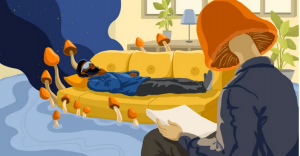by Fraser Hibbitt for the Carl Kruse Blog
‘To fathom hell or soar angelic
Just take a pinch of psychedelic‘
-Dr Humphrey Osmond – as quoted in a letter to Aldous Huxley
In 2016, a controlled number of terminally-ill patients were administered low doses of psilocybin in efforts to alleviate the anxiety of passing away. The trial was successful in allaying the existential dread for the majority of the sufferers, with this positive feedback persisting in the follow-up evaluation six month later. It is not that they were happy to die but instead aware of what they faced, aware that it should be so. In his last hours, Aldous Huxley famously provided a similar consolation for himself, knowing well where it would take him. Knowing and experiencing share a difficult relationship; Huxley could not die merely knowing what the injection of LSD would reveal, rather, once more, he had to experience it.
Huxley’s consolation occurred in 1963. Now, in our own time, psychedelic therapy is beginning to be explored precisely for this experience. Of course, there was a period, beginning with Albert Hoffman’s synthesis of LSD in 1943 and the subsequent distribution by Sandoz Laboratories of the chemical, where studies into the therapeutic possibilities of psychedelics were openly and legally discussed; findings abounded as to the wide-ranging application of the drug: addiction, autism, and a host of neurotic maladaptations. It was in 1953 that Huxley first got his hands on the mescaline that provided The Doors of Perception, a seminal text in explicating on the psychedelic experience and its spiritual value.
Between the poles of Hoffman’s synthesis and the terminally-ill administration, the psychedelic experience remained, and to some extent still does, on the fringes of society, associated with the hippie movement and new age spirituality. Now it is in the rigorous depths of the science lab working towards state approval, and with pleasing results to any utilitarian mind: depression and anxiety, eating disorders, PTSD, and addiction have all shown to be ameliorated under the careful consideration of psychedelics. There are various ways of introducing these substances into the therapeutic practice, and these methods stem from the original procedures conducted during late 40s and 50s: drug-assisted therapies, a pinch of psychedelic with psychoanalysis or CBT; psychedelics alone; guided psychedelic use.
‘That chair – shall I ever forget it? Where the shadows fell on the canvas upholstery, stripes of a deep but glowing indigo alternated with stripes of an incandescence so intensely bright that it was hard to believe that they could be made out anything but blue fire.’. This is Huxley’s experience of a chair in his garden after ingesting mescaline. The associations and limitations of perception have been cast aside, albeit enhanced, but nevertheless broken away from. It will be known that our perception of the world is intimately engaged with our state of mind. Citing the case of the paranoiac perhaps belies this intimacy, for it can be largely implicit, nimble and intuitive. It seems to be there is a difference between perceiving an object, reading an object, and reading a person. It is true, there are interests of our attention, and how we pay attention – what kind of attention – which cohere around, and inform, our current mental state. A lack of flexibility in perceiving and paying attention is needed sometimes, but it can mire the more pernicious sides of our self.

Aldous Huxley
Huxley, of course, was a man of letters and of prodigious learning and brought this to his experience of mescaline, yet that has nothing to do with the flexibility that the mescaline provided. The curiosity remains the same, and an interesting question arises about why finding a chair so fascinating could hint at some kind of breakthrough. The psychedelic experience is a simultaneous ‘loosening’ of fixations both internally and externally. In observance – Huxley’s chair – there is the re-minding, re-finding, of form and colour, wonder and enjoyment. If a sufferer of a mental ailment explains their problems with perception, it is that there is either little attention to things asides from practicality, or there is no curiosity at all in observing; this extends also to the over-associated objects which may betray the inward life of a sufferer, objects that ‘trigger’, for here is a fixity that renders the sufferer’s perception powerless and isolated. To perceive the world anew is tantamount to an open mind, not one isolated by the suffocating demands of mental illness.
What is clear that a new relationship in perception is needed for one who struggles with living; to see an object as a thing worth observing, to see the inward life as rich and expansive. If an object can reveal new and un-before recognised qualities then, perhaps, thinking about thinking can reveal something similar. This is the idea behind the use of psychedelics as an adjunct to psychotherapy or CBT. In the case of psychotherapy, it can be difficult for a meaningful relationship to be established between the therapist and the seeker. There are a host of defence mechanisms, transferences and evasions that can occur. What the psychedelic does is help to break down these barriers, and begin the work proper; the healing process.
The re-shaping of the ego is akin to perceiving the suggestiveness of life again. This is what is hoped and this is what the initial trials seem to be revealing. Of course, this is not to be thought of as another ‘golden bullet’. Most people have heard of a ‘bad trip’ and a sense of disconnect from reality. For someone undertaking recovery from the depths, for example someone suffering from PTSD, there remains the problem of re-traumatisation. This is when the body is not ready to open again, and being forcibly opened, by therapy or by drugs, only reinforces the effects of trauma. This is why some psychologists opt for the ‘Psycholytic’ method: small doses taken every one to two weeks with careful observance and a constancy of feedback.

Psychedelic therapy is, then, another theme on the fight for recovery that has crept into the needs of our cultural and mental existence in the last few decades. Self-awareness and the mindfulness drive is reminding us that we may have formed a society where security has enabled laxity in the self; we do not necessarily have meaning, or a sense of wonder, when we are secure. In the preface to his novel Crash, J.G. Ballard writes: ‘we live in a world ruled by fictions of every kind – mass-merchandizing, advertising, politics conducted as a branch of advertising, the pre-empting of any original response to experience by the television screen’. Ballard also wrote the foreword to the vintage edition of Huxley’s The Doors of Perception. The acceptance and consideration that psychedelics are now undergoing is an attempt to restore in the mind an original response to experience, and this, on a single day, can be an enormous victory.
===============
This Carl Kruse Blog Homepage is here.
Contact: carl AT carlkruse DOT com
Other articles by Fraser Hibbitt include the James Webb Telescope and on Google Glass.
The blog’s last post was on AI Theater.
Find Carl Kruse on Vator and on this other blog.

Happy to see that research in the therapeutic of psychedelics has been increasing dramatically in recent years.
It’s quite a seismic shift in public as well as scientific opinion.
Carl Kruse